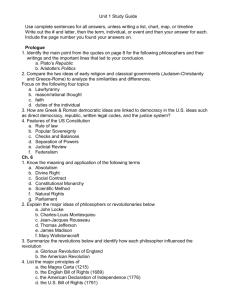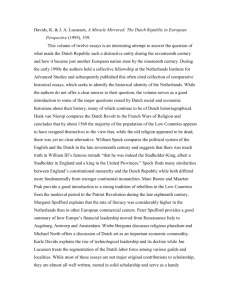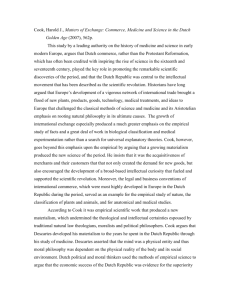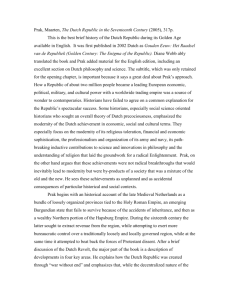extended
advertisement
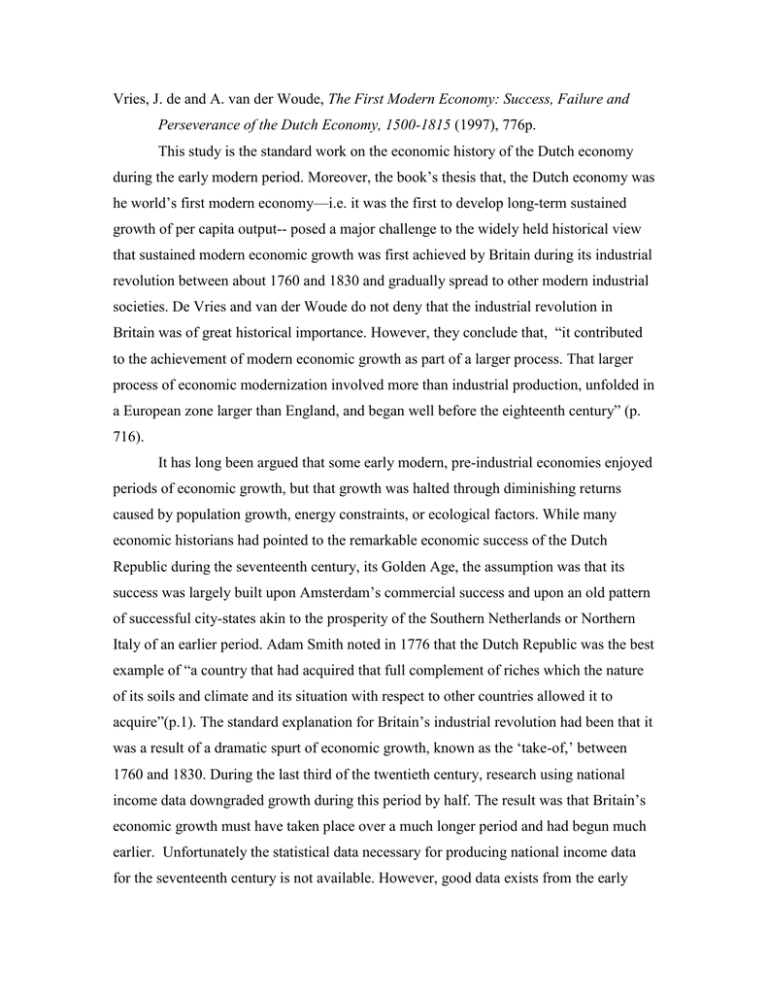
Vries, J. de and A. van der Woude, The First Modern Economy: Success, Failure and Perseverance of the Dutch Economy, 1500-1815 (1997), 776p. This study is the standard work on the economic history of the Dutch economy during the early modern period. Moreover, the book’s thesis that, the Dutch economy was he world’s first modern economy—i.e. it was the first to develop long-term sustained growth of per capita output-- posed a major challenge to the widely held historical view that sustained modern economic growth was first achieved by Britain during its industrial revolution between about 1760 and 1830 and gradually spread to other modern industrial societies. De Vries and van der Woude do not deny that the industrial revolution in Britain was of great historical importance. However, they conclude that, “it contributed to the achievement of modern economic growth as part of a larger process. That larger process of economic modernization involved more than industrial production, unfolded in a European zone larger than England, and began well before the eighteenth century” (p. 716). It has long been argued that some early modern, pre-industrial economies enjoyed periods of economic growth, but that growth was halted through diminishing returns caused by population growth, energy constraints, or ecological factors. While many economic historians had pointed to the remarkable economic success of the Dutch Republic during the seventeenth century, its Golden Age, the assumption was that its success was largely built upon Amsterdam’s commercial success and upon an old pattern of successful city-states akin to the prosperity of the Southern Netherlands or Northern Italy of an earlier period. Adam Smith noted in 1776 that the Dutch Republic was the best example of “a country that had acquired that full complement of riches which the nature of its soils and climate and its situation with respect to other countries allowed it to acquire”(p.1). The standard explanation for Britain’s industrial revolution had been that it was a result of a dramatic spurt of economic growth, known as the ‘take-of,’ between 1760 and 1830. During the last third of the twentieth century, research using national income data downgraded growth during this period by half. The result was that Britain’s economic growth must have taken place over a much longer period and had begun much earlier. Unfortunately the statistical data necessary for producing national income data for the seventeenth century is not available. However, good data exists from the early nineteenth century and this shows that the Dutch economy had a relatively modern structure. Only Britain had such a small percentage of its labor force in an efficient agricultural sector as the Netherlands. The authors conclude that the Dutch had a diversified economy capable of economic growth before its industrial revolution, which did not take place until the late nineteenth century, and yet it had a per capita national income that was still higher than Britain’s. Already in 1973, the well-known institutional economic historians, Douglas North and Paul Thomas, argued that the Netherlands was “the first country to achieve modern economic growth as we have defined it…” Angus Madison argued in 1991 that “during the last four centuries there were only three ‘lead’ countries [defined as the country which operates nearest to the technical frontier, with the highest average labor productivity]. The Netherlands was the top performer until the Napoleonic Wars, when the UK took over. The British lead lasted until 1890 when the USA took over” (p. 2). In this study de Vries and van der Woude have supplied the data and analysis for the argument that the Dutch Republic was the first modern economy. This substantial book is based upon a wealth of scholarship and offers a comprehensive and detailed discussion of the Dutch economy between 1500 and 1815. It includes many statistical tables, figures and maps. It is divided into three parts. Part I, Structure, begins with geography, including the little ice age, land reclamation, energy supplies, especially peat. It goes on with chapters on demography; money, taxes, borrowing and lending; commercial finance; and ends with such interesting questions as whether it was a Calvinist economy and if it can be described as an integrated ‘national’ economy. The second section has detailed chapters on agriculture, fishing, industry, and foreign trade. The third section is an analysis of the dynamics of the economy, with chapters on the city and the rural areas, the social structure of a modern economy, the standard of living and the labor market, a macro-economic analysis of the economy over time, and an analytical discussion of the prevailing interpretations of an advanced preindustrial economy. The authors argue that neither the Malthusian model, nor the model of merchant capitalism and its Stapelmarket (literally the clearing house of Europe’s surplus goods), are adequate to describe the Republic’s economic model. Instead, they argue that the Republic was the first example of a modern economy. Much of the detail of the book hammers home the argument that this was a national well-integrated market economy that allocated resources efficiently through a free market in capital, land and labor. Wages for skilled workers, for which the data is best, increased in purchasing power although the country absorbed many immigrant workers. The authors include an impressive amount of data on the specialization of labor. Both agricultural and industrial prices were unusually market dependent and sensitive to changes of inputs. Modern market economies show a high level of uniformity in prices of basic commodities and this was a characteristic of the Republic’s economy, as demonstrated for example by grain prices, despite the fact that there was a great deal of difference between the commercial and industrial maritime zones and the more agricultural inland areas. One of the most important characteristics of the Dutch Republic was its pre-eminence in foreign trade. This study includes a thorough explanation of the Republic’s foreign trade, including a great deal of statistical data, but it concludes that foreign trade did not “act as the engine of growth” for the Republic. Instead, they emphasize the role of an efficient agriculture, the fisheries and industrial production. They define a modern economy as “one with features that assist in the process of institutional, organizational, and technological change that improve the efficiency of production and distribution” (p. 713). For the Dutch Republic, urbanization, social mobility, and political and legal development were key factors in the creation of a modern economy. The rate of urbanization achieved in the Dutch Republic by the midseventeenth century was not realized anywhere else in Europe until the nineteenth century. This high level of urbanization provided everyone in the country with access to economic and market information. The Dutch also had a higher rate of literacy, had greater access to secondary and higher education, and had the highest per capita book publication. The Republic’s public passenger barge system was the most effective public transportation and communication system in Europe. It attracted the most skilled workers, some of which brought a good deal of capital with them, and it employed many foreign unskilled workers. There is less known about social mobility but the increasing specialization of workers suggests the existence of a modern labor market. The Republic was a highly monetized economy and its banking, stock market and insurance industries were highly developed. The Republic’s decentralized state has often been seen as backward looking in a period characterized by the growth of centralized national monarchies. The authors argue that the United Provinces, however chaotic it might look to us, functioned quite well. It “was a well-ordered government’ capable of protecting the security of its citizens in a hostile world, nurturing the economic interests of its merchants and fishermen, establishing vigorous institutions to advance its colonial ambitions, and maintaining domestic tranquility” (p. 714). It developed a program of poor relief that was the most comprehensive in its time. It developed a tax system that was able to raise more revenue per capita than any other state in Europe and did so in a fairly progressive manner. These and other factors, according to the authors, placed its economic actors “in a dynamic setting conducive to innovation.” In addition to these modern economic features, the authors explain that the Republic also had social characteristics that we consider modern. These included religious toleration, a household structure consisting primarily of nuclear families with few nonfamily residents, a relatively open and complex social structure, and a political system that, although it can not be characterized as open to broad public participation, was “ideologically anti-absolutist and in practice sensitive to the interests of its citizens.” They conclude that the Dutch Republic “pursued an sociopolitical path that appeared reactionary to the conventional wisdom of absolutist Europe in order to establish a precocious modernity” (p. 715). Despite its very decentralized constitution, the Republic was capable of taking forceful action, especially in the international arena. During the seventeenth century there was little criticism within the Republic of its complex constitution and the only persistent problem was the role of House of Orange within its constitution. It was not until the eighteenth century, when the increasing burden of a large and growing national debt, produced more serious internal dissension. Except for the replacement of tax farming with directly collected excise taxes, vested interests rejected major reform. As a result the Republic developed a reputation that blamed both its relative stagnation and the failure of its Batavian Revolution of the 1790s on its tradition of what was seen as an archaic system of decentralized government. In a comment that has some resonance to the political gridlock of our own time, the authors argue that the problems of the Netherlands in the late eighteenth century “may be understood most fruitfully as an early version of a ‘distributional coalition’ problem common to rich, mature societies” (p. 715). The book ends with a fascinating ‘Postlude’ chapter that discusses the implications of their work for the concepts of modernization, the industrial revolution and modern economic growth. The broadest implication of their work is the notion that modern society did not originate with the French and industrial revolutions. Secondly, in an increasingly post-industrial world, the view that all modern economies have to go through a traditional industrial revolution in order to be considered modern has to be rejected by the experience of the Netherlands during the early modern period. De Vries and van der Woude argue that many economists and social theorists have defined a modern society, as Max Weber suggested, as consisting of modern humans who are by nature rational, “calculating instead of magical, individual instead of communal, and generally demystifying…[which leads us to] economic man, the rational actor seeking to maximize economic well-being.” The authors remind us that historical context matters and such a model is too simplistic, since that what is rational to those in earlier times may seem puzzling to us. Another thought provoking implication of de Vries and van der Woude’s book is their questioning of the assumption that modern economic growth is self-sustaining and essentially limitless. The classical economists of the late eighteenth and early nineteenth century had argued that population growth and energy and resource supplies would eventually produce diminishing returns that would eventually halt growth in a developed economy and lead to a stationary state. This was not an unreasonable assumption in an essentially organic economy in which the supplies of food, raw materials and fuel all competed with each other for the use of a limited supply of land within he context of a growing population, The industrial revolution fundamentally changed this age-old system when it began to use the vast supplies of mineral resources stored in the earth. The invention of the steam engine and the use of coal-based iron smelting had a revolutionary impact upon the economy and helped produce what we know as the nineteen-century age of progress. The authors argue that the Dutch Republic had already freed itself from the pre-industrial energy restraints during the early modern period through its intensive use of organic and kinetic energy. Its economy was largely based upon its abundant peat supplies, which were far from exhausted during the period. During the eighteenth century this was supplemented with coal from Newcastle at a price similar to what London paid. The relative decline of the Dutch economy during the eighteenth century was not a result of energy supplies. In fact, they show that the Dutch were early adopters of steam engines, especially for pumping water from their polders. They did not, however, use steam-power for industrial production until much later in the nineteenth century because their industrial production was already too costly and could not be lowered sufficiently through the use of steam. The main reason why they did not adopt steam power early, according to the authors, was not a supply constraint issue, but a “demand-delayed transition from a first to a second stage of modern economic growth” (p. 720). The recent experience of mature industrial economies has demonstrated that t heir economic growth has been much slower than the high rates of economic growth of developing economies. The authors note that supply restrains upon economic growth look now much more seriously today than they did during the boom years after World War II. In addition, they note, that the demographics of modern economies will mean that there will be far viewer younger workers and many more older and retired people in the near future. De Vries and van der Woude suggest that the Dutch economy was also modern in the sense that it pioneered long-term growth and then entered a period of relative stagnation, and that this pattern may be a much more characteristic of modern growth than an endless age of progress.


